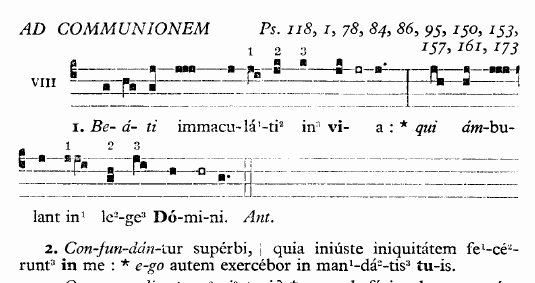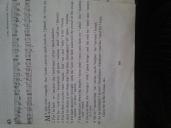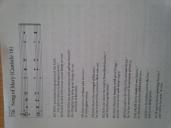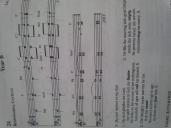Pointing Text for Gregorian Psalm Tones
-
Does anyone know of a very readable system for pointing a number of english verses to a gregorian psalm tone? A lot of the ways I've seen it done can be awkward or hard to decipher.
-
There are lots of systems. I can describe half of dozen without even thinking hard.
"Very readable" depends very much on how familiar the readers will get, expert or occasional; what the range of music is, just the usual Office and/or Gloria Patri tones or also other things; how conventional (and based on modern English, Latin, or Anglican conventions) your pointing method is, where the flexes and stresses and cadence syllables go in the line; and how much flexibility and space you have for typesetting.
For one-off psalms and inexpert cantors I'd suggest the Versus Psalmorum method, which explicitly numbers the syllables that are not to a reciting tone, and shows the numbers explicitly in the notation paradigm. -
I would commend a studied familiarity with St Dunstan's Plainchant Psalter (Lancelot Andrewes Press) for learning how to set English to Gregorian tones. There are no categorical rules. One needs to be an artist musician who has a very good sense of how to match tones that were designed quite thoughtfully to be sung with the Latin tongue and its quite regular accentual structure with any language blessed with a different one. When using these tones for English and its very irregular accentual structure, a great amount of musical artistry is needed to obtain results which can (despite those who gruntle that it can't be done) be very admirable. As we all know, the Anglicans have been doing this for a very long time, and do it much better than most Catholic efforts, which, typically, mangle the language or the tone, or both, resulting in incredibly awkward and artless performances.
Too, the translation one uses makes all the difference in the world. Coverdale is much better that Revised Grail, et al., because of its more gracious syntax. For a modern translation that works reasonably well, that in the '79 BCP is not bad.
There is one important aspect to how one approaches this procedure that is fundamentally different with English. The Gregorian tones are each designed for specific alignment with grammatical accent and accent pattern in the tone's cadences. Often, such alignment will be evasive in English, which means that one needs to finesse word patterns and cadential formulas with artful invention and a strong sense of good musicianship. The results can yield English performance that is equally as beautiful as Latin. One will notice in the efforts of the better Anglican sources that the structure of the cadences is not at all savaged in setting the tone to English. Catholics (for some reason!) will typically put two syllables on what is supposed to be a one-syllable podatus, or will put two notes where there is supposed to be only one, or will add notes where they don't exist in the original tone. Such licenses yield very inept and amateurish results, but are to be found in even the best Catholic books. In closing, one will observe that great care must be exercised in the choice of which tone to fit to which psalm. Some tones, and their specific final cadences, work much better than others for a given psalm.
Do get yourself a copy of St Dunstan's Plainsong Psalter and avail yourself of many recordings of English choirs singing the psalter to the Gregorian tones. These latter are good for study of syllabification, but not for their typically accentless and monotonic delivery. -
I think Bartlett's method for the LC series is the most immediately obvious, requiring the least instructions to singers.
Also, One thing that I have realized helps a lot is to have the first verse fully notated, with the pointing embedded in the text under the notes. Then using the same pointing for the rest of the verses people understand what the italics or*or linebreaks or double bars or pipes or whatever it is that you're using means.Thanked by 1Andrew_Malton -
I use Finale, one line for the first half, a second line for the other. I export it as a graphic and insert it "behind text" in MSWord. Then I just type or paste the desired text under the melody line.
-
Can I recommend the (somewhat overdone) system I devised for By Flowing Waters?Thanked by 1M. Jackson Osborn
-
Paul F. Ford, how does your system work? Is there a link or pdf?
-
This conversation needs pictoral examples and actual discussion on the ins and outs of a particular system. Also, it would be helpful to have some more information.
- Do you want to discuss a system for determining where the notes should line up with the syllables (a musical/grammatical system)?
OR
- A system for displaying on a piece of paper (or whatever) those musical decisions (a typographical system)?
Of course - these have to work together. For example some musical systems have no melismas, and assign each note in a formula to a single syllable at the end of a line. So all that is needed is to notate the first note in a line that changes form the reciting tone.First you sing all the words on a single note and | then you start to change.
This musical system has scant typographical needs. On the other hand, texts pointed for Anglican chant tones usually need to provide a lot more information.Lots of syllables on a single chord but then one | for each | chord *
Can be notated rather simply in a way | makes things | clear for | everyone.
But depending on whether you typically appoint for each chord | one or · many | syllables *
You may have to be more or less ex- | -plicit · with | where the div·isions | are.
And naturally it matters whether this will be used by people once, and they need to get it immediately, or whether it is something that a coherent group will work with over time. I love St. Dunstan's, for example, but I wouldn't hand it out to people who had never used it and expect it to go well in a liturgy.
May I suggest that Ben Yanke OP provides at least a single example of the psalm tone with a fully notated text of at least one verse, and also some additional information on how this might get used.Thanked by 1MarkThompson -
Well, let's start getting specific.
The 1961 Desclee book Versus psalmorum et canticorum has this pointing format:
This isn't a recommendation, just an example of one approach to pointing.

 image15.png535 x 283 - 30KThanked by 1eft94530
image15.png535 x 283 - 30KThanked by 1eft94530 -
I'm attaching what we are doing this Eastertide - the same as last year, but with all the verses for Year C.

 Alleluia OFilii-Eastertide-I II III-C.pdf587K
Alleluia OFilii-Eastertide-I II III-C.pdf587K
 Alleluia OFilii-Eastertide-IV-Ascen-C.pdf590K
Alleluia OFilii-Eastertide-IV-Ascen-C.pdf590K
 Alleluia OFilii-Whitsuntide C.pdf589K
Alleluia OFilii-Whitsuntide C.pdf589K -
And here are the Propers from our High Mass for Corpus Christi 2015.
The Gregorian parts are in the style of Rev. Carlo Rossini's "Propers" book. In order to complement the "Kyrie" from the Haydn Mass we performed, we used an Anglican double chant alternating in the Introit: the first and last sections only for the Psalm, then the entire chant, through composed with rhythms for the reiteration of the Antiphon. This led very nicely into the Ordinary without any pause.
The Sequence uses hymn tunes from "The Hymnal 1940" with the Latin text. We also had the strings and winds double the SATB on the it.
 CorpusChristi-Propers-2015.pdf247K
CorpusChristi-Propers-2015.pdf247K
 Weman-h-CCSeq-A.pdf22K
Weman-h-CCSeq-A.pdf22K
 Weman-h-CCSeq-B.pdf20K
Weman-h-CCSeq-B.pdf20K
 Weman-h-CCSeq-C.pdf18K
Weman-h-CCSeq-C.pdf18K
 Weman-h-CCSeq-D.pdf20KThanked by 1CHGiffen
Weman-h-CCSeq-D.pdf20KThanked by 1CHGiffen -
Some more examples of pointing methods
1 The Book Of Common Praise (1938)
2 Common Praise (1998)
3 The Canadian Psalter (1963)
4 The Catholic Book of Worship (III, 1994)

 IMG_20160410_122001.jpg3264 x 2448 - 1M
IMG_20160410_122001.jpg3264 x 2448 - 1M
 IMG_20160410_121943.jpg3264 x 2448 - 1M
IMG_20160410_121943.jpg3264 x 2448 - 1M
 IMG_20160410_121858.jpg3264 x 2448 - 1M
IMG_20160410_121858.jpg3264 x 2448 - 1M
 IMG_20160410_121932.jpg3264 x 2448 - 2MThanked by 1Casavant Organist
IMG_20160410_121932.jpg3264 x 2448 - 2MThanked by 1Casavant Organist -
Steve, are you at Walsingham in Houston? I always forget!
-
Bruce, I was there for 16 years, but left in 2003. I'm at Stella Maris on Sullivan's Island (Charleston Harbor) now.Thanked by 1BruceL
-
Oh wow! I'm just a little behind! There's a fellow from Birmingham that might have been there somewhere along the line lately, although it could be Wilmington or something further North. Beautiful church!
Welcome to the MusicaSacra Forum!
To participate in the discussions on Catholic church music, sign in or register as a forum member, The forum is a project of the Church Music Association of America.
Categories
- All Discussions21,079
- General Music Discussion8,207
- Job Openings195
- Management of Music Programs850
- Choral Matters532
- Church Documents and Rubrics524
- CMAA Notes300
- Events715
- For Newcomers: Read First26
- Sacred Polyphony546
- Hymnody871
- Gregorian Chant: General2,694
- ↳ Graduale Romanum and Liber Usualis367
- ↳ Graduale Simplex60
- ↳ Semiology63
- Vernacular Plainsong696
- Anglican Use and Anglican Chant68
- Organ, Other Instruments and Repertoire434
- New Composition/Works in Progress1,288
- Recordings230
- Music for Hispanic Ministry159
- Music Education: Children211
- Music Education: General222
- News Items245
- Positions Wanted2
- General Discussion: Catholicism738
- Amusements176
- General Discussion1,033
- Opinions117




